One of fashion’s biggest buzzwords is “sustainability.” You’ll see and hear brands making claims left and right about how they’re reducing their impact on the planet. But next thing you know, you’re seeing an article debunking those same claims.
So what’s the truth about sustainable fashion and style?
Is it possible to have a responsible wardrobe? And what is fast fashion versus slow fashion, anyway?
We’ve got all your answers right here. Keep reading for NLW’s explainer on how to make your closet more eco-friendly, including brands to shop.
Table of Contents
What Is Sustainable Fashion?
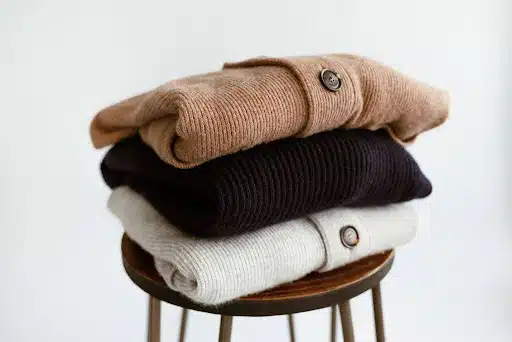
Sustainable fashion is a movement to make products more environmentally friendly and conscious.
This includes companies being more mindful about how they produce clothing in a way that reduces ecological impact. But, on the individual level, it can look like choosing not to overbuy or only buying clothing and other fashion pieces from sustainable sources.
So what does that look like in real life? Here are just a few examples:
- Recycled materials. Many people don’t know that there’s a massive amount of waste in the fashion world. That’s why some brands take products and materials that they would usually throw away (ending up in landfills or our oceans) and use them to create new items instead
- Organic and natural materials and dyes. Some synthetic materials and dyes are harmful to the environment and humans. Think pesticides, fertilizers, or even flame retardants. Using organic and natural processes and materials uses less hazardous chemicals.
- Upcycling. This is something you can do, and probably have done on your own. Upcycling takes an item that already exists and finds another way to use it. For example, maybe you have an old college Tee you love but you’ve outgrown wearing it. Instead of trashing it, you could incorporate it into a quilt or turn it into a cute bandana for game days.
There’s also an ethical component to the world of sustainable fashion. It encourages and supports responsible sourcing, safe and fair trade working conditions, reduced energy and water waste, and more.
Understanding what sustainable fashion is can feel daunting. There’s a lot to it! But the general idea is to reduce your environmental footprint to help the planet and others.
What Is Fast Fashion?
Fast fashion refers to mass-producing cheap, often trend-focused clothing at a rapid rate. It usually comes from giant retailers as a way to prioritize quantity over quality to maximize their profit.
What’s the problem with fast fashion? Well, in order to make all of that clothing quickly at such low prices, there’s a huge environmental and social cost.
These trendy, cheap clothes contribute to overbuying and wastefulness on the part of the consumer. But they also cause waste at the production level. These companies aren’t recycling products or worrying about their pollution levels. (And they’re certainly not using natural or organic materials.)
On top of that, fast fashion factories are known for their terrible working conditions, lack of fair pay, and exploiting poor workers in third-world countries.
If you’ve ever been to a mall, you’ve been surrounded by fast fashion stores. Everything from the obvious culprits like Forever 21, Garage, and H&M to pricier options like Urban Outfitters, Gap, and Victoria’s Secret are all fast fashion brands.
But let’s be honest, some of the biggest fast fashion offenders aren’t in the malls. They’re online.
Shein anyone?
Shein may be the most famous example at the moment of over-the-top fast fashion, but it’s not alone.
Open up Instagram and it’s only a matter of time before you’re hit with an ad from a brand you never heard of that’s hawking knock-offs of what your favorite celebrity was wearing yesterday at suspiciously low prices.
So how do we get away from fast fashion? We’ll cover that next.
What Is Slow Fashion?
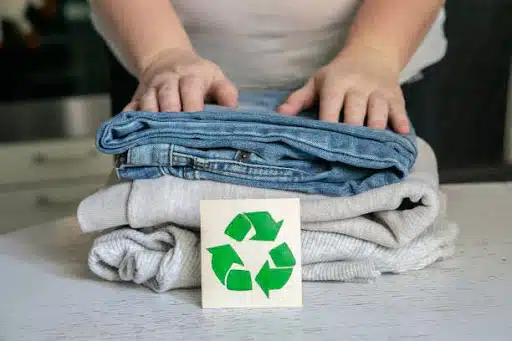
Slow fashion is the polar opposite of fast fashion. It’s part of the sustainable fashion umbrella.
Basically, the idea of slow fashion is to put quality over quantity. It’s all about producing and purchasing well-made, timeless pieces instead of chasing trends.
It also means bringing intentionality back to the way you shop.
What does that mean?
Here’s an example. Have you ever found yourself walking around a store for way too long, so you just buy something so you don’t leave empty-handed? Or have you ever given in to an impulse buy at Target when you were supposed to only go in for one specific thing?
That’s unintentional shopping.
Intentional shopping means going into a store with a plan and a list and sticking to it. You only buy an item because it checks all of your boxes and you truly need it.
Another part of slow fashion is doing your research. We know it takes time but it’s worth it to make sure you’re buying things that are good for you and good for others.
Check the tag before you make a purchase, or look up information about a brand before you hit “Order.”
Why Is Sustainable Fashion Important
So we’ve told you a lot about sustainable fashion, but why does it matter? Why should you avoid those fast-fashion brands and shift your lifestyle towards slow fashion?
Sustainable fashion is important because the fashion industry is the second biggest polluter in the world.
According to Business Insider, it makes up 10% of total global carbon emissions. On top of that, 85% of textiles end up in landfills each year.
And that’s not all. It’s also estimated by researchers that the fashion industry uses 1.5 trillion liters of water each year. When many regions struggle more and more with drought and dwindling access to clean water, this level of waste and usage is incredibly devastating.
In short, sustainable fashion is a way to reduce our impact on the planet and to protect important, limited resources.
How To Create A Sustainable Closet (The NLW Way)
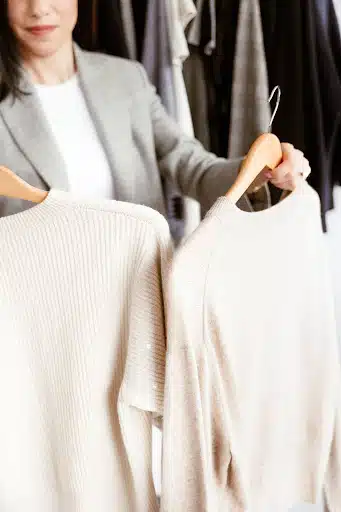
Ready to make environmentally friendly changes to your wardrobe? You’ve come to the right place. The core values of slow fashion actually line up perfectly with Next Level Wardrobe’s Style System.
We believe in being conscious about what you’re buying and putting on your body. We also believe that investing in well-made, timeless pieces instead of trendy items is essential to having great style.
Think about it: classic pieces are more versatile. You can wear them for multiple dress codes and occasions for years to come without looking dated.
Plus, if they’re well-made, they’ll last you. That means you won’t have to needlessly waste time, energy, and money constantly replacing items in your closet.
With that in mind, here are NLW’s top three tips on how to create a sustainable closet.
1. Skip the Sales
We all love the thrill of a great deal. Feeling like you’re getting a bargain or unlocking an exclusive discount code is the best.
But here’s the truth: it’s not worth it.
For one, sales are how companies move “deadstock” aka, the leftover clothes from last season no one wanted. They need to make room for their new inventory, so they slash prices on older items. That means you end up with pieces that are either too trendy, out of season, or even damaged.
Second, not all sales are real. Some companies tell you an item’s on sale when in reality, they haven’t changed the price. They count on you seeing bright red “Sale!” signs or “30% off” text on your screen and assuming you’re getting a deal.
Third, there’s nothing like a sale to get you to make an impulse purchase. A lot of people don’t want to feel like they’re missing out on a deal. So even if they don’t really want or need anything from a sale, they’ll purchase something just to not “waste” their discount.
That’s how you end up with pieces that you wouldn’t normally buy and that you probably won’t wear.
2. Don’t Sleep on Second-Hand and Consignment Stores
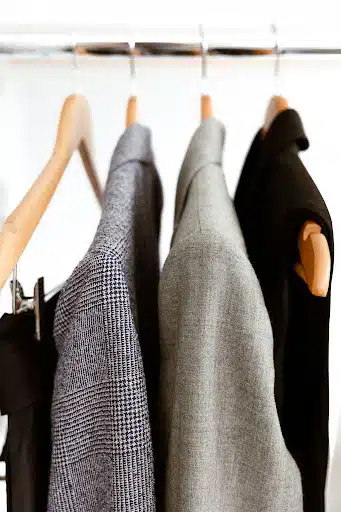
Wondering where to buy sustainable clothing? Consider second-hand and consignment stores.
While not all clothing in these stores is necessarily sustainably made or even ethically sourced, you’re purchasing pre-existing, pre-owned clothing. That means you’re not contributing to the production of more clothing.
However, you can still make sure you’re purchasing well-made, quality clothing. All it takes is time and patience. Go slow and search the racks for pieces made from sturdy materials or well-known, quality brands.
3. Have a Plan When You Go Shopping

One of the simplest things you can do to be more sustainable is to have a plan when you go shopping.
Before hitting the shops, take stock of your closet. Look at what you already have and ask yourself, “Do I need to buy anything? Or do I have everything I need for now?”
If you do have gaps in your wardrobe, then it’s time to make your shopping list. Identify what you’re missing. Then answer these four questions:
- Why do I need that item?
- Where and when will I wear it?
- Is this a purchase for a one-time event that I won’t wear again? If so, should I consider renting an outfit instead?
If you’ve answered these questions and you do actually need to buy something, it’s time to make a checklist. Write down everything this item has to have for it to earn a spot in your closet.
Use this list to hold yourself accountable while you’re shopping. If a piece of clothing doesn’t check all the boxes, keep looking.
Not only is this a more sustainable way to shop, it’s just plain better. This way, you’re only buying clothes you truly need and love. That means you’re more likely to get more use out of these items.
Where To Buy Sustainable Clothing: Our 3 Favorite Slow Fashion Brands
Thrift stores can’t have everything.
When you need to buy new, that’s where slow fashion brands come in. These labels have more ethical and ecological options so you can dress well and feel good.
Not sure where to buy sustainable clothing? We’ve got you covered. Here are NLW’s three favorite slow fashion brands worth checking out.
1. Arch4
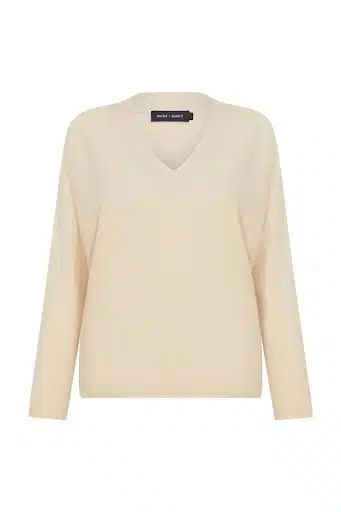
Shop here.
Looking for where to buy high-quality clothes that don’t hurt the planet? Try Arch4.
UK-based brand Arch4 is a must-shop for all things Cashmere.
Cashmere is one of the most ecological (and ethically) devastating materials.
For one, it takes a high amount of water to maintain Cashmere goats’ grazing fields, and a lot of water pollution to process and clean cashmere fibers. For another, many unethical companies wipe out existing native communities and farmers to accommodate their Cashmere goat factory farms.
This not only hurts locals but also harms biodiversity.
Finally, Cashmere farming often harms the goats themselves as they’re abused, cut, and even killed in harsh shearing processes.
So what does Arch4 do differently? For one, all of their suppliers are certified sustainable and traceable. They’re sourcing process is traceable back to each individual herder.
They also clean wastewater instead of dumping it and use the purified water to irrigate local fields.
To avoid soil and plant degradation, Arch4 rotates their herds throughout their land plots as well.
Finally, they only harvest cashmere wool via hand-combing. This avoids hurting or stressing the goats. They also only comb the goats during the spring when they would naturally shed for the warmer seasons.
2. Triarchy
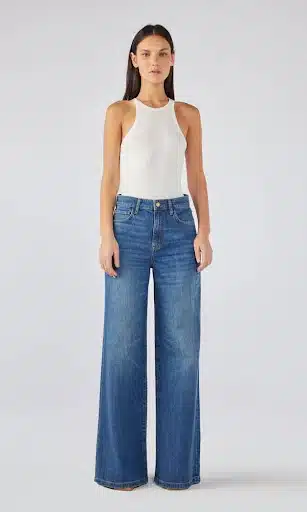
Shop here.
What brands are not fast fashion? Triarchy makes the list.
Founded in 2018 under a mission of sustainability and reducing waste, Triarchy is the proud creator of the world’s first and only 100% plastic-free denim.
The only materials they use are certified organic cotton, recycled cotton, tencel, and Refibra, a natural rubber.
They wash their fibers responsibly to reduce water consumption and avoid chemical usage.
Another fact about Triarchy? Once a pair of their jeans reaches the end of its lifetime, it only takes two years or less to biodegrade. The industry standard is 200 years.
Last but not least, they don’t expect you to take their word for it when it comes to their sustainability claims. They submit to third-party audits each year to fact-check their impact.
If you’re searching for high-quality, comfortable, and versatile denim, Triarchy is for you.
3. Frank And Oak
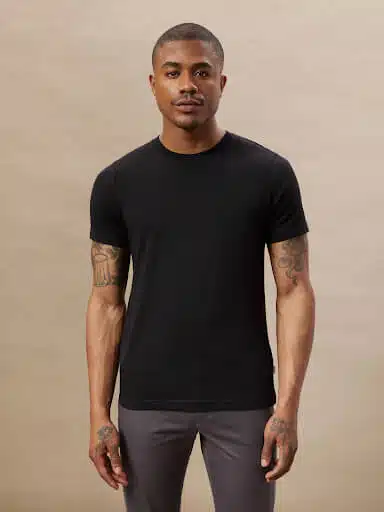
Shop here.
Frank And Oak’s mantra is “Inspire a better way of living.”
They believe in creating women’s and men’s clothing that contributes to a cleaner and more mindful lifestyle.
So what does that look like for this Canadian brand?
First, they’ve innovated their fabrics to be as earth-friendly as possible.
For example, they use Kapok instead of cotton, which is five times lighter than cotton and consumes way less water during production.
Another cotton alternative used is Hemp. It needs 50% less water and Frank and Oak grow their hemp pesticide-free. Add to that a long list of recycled fabrics like recycled polyester, nylon, and cruelty-free wool, and it’s easy to see that Frank And Oak mean business.
Frank And Oak also keeps their packaging minimal to avoid unnecessary waste. When they do need packaging for shipments, they use compostable polybags instead of single-use plastics.
Finally, the brand also makes sure its stores and offices are community-minded and eco-friendly. They work with Canadian artisans and use recycled materials to design and build their locations.
Shop their timeless styles with a clear conscience.
Need help on your sustainable fashion journey? Apply for Next Level Wardrobe’s women’s and men’s styling services. Our team not only knows how to create a versatile, stylish wardrobe you’ll love, but we make sure it’s personalized to you and your values.



